I am pleased to quote an interview from the research team of the Aristotle University of Thessaloniki (AUTH) on the creation of an optical cache. Below are their answers regarding the difficulties they face and the challenges they will face in the future.
How did the idea start, and what challenges needed to be addressed in the early stages?
Today, the high-performance computing (HPC) community is working towards achieving the next computing achievement, i.e., the exascale milestone, a quintillion (1018) calculations each second that is a much higher level of performance in computing. This computing milestone is expected to have a profound impact on everyday life. However, one of the main challenges in computing systems remains in the growing gap formed during past decades between a processor and memory performance, also known as the “Memory Wall” problem. This problem raises new concerns about its impact on the applicability of any future computing processing progress, as even if the processor speeds radically increase, the system’s performance will still be degraded by the lower frequencies of the memory system. Although the memory bottleneck is a highly complex problem, in simple words, we can say it is primarily lying in the limited speed performance of electronic random-access memory (RAM), where clock speeds do not exceed a few GHz.
To cope with this situation, designers have turned to memory hierarchies, i.e., different types of cache memories with small capacity that are placed in proximity with the processor units (on the same chip), to secure low-energy and low-latency data access. However, this situation has lately resulted in processors’ chips, with more than 40% of the CPU chip real estate being reserved for on-chip cache memories and their associated interconnects. As a result, most of the space of the processor’s chip is devoted to storing rather than computing, which was its original goal. Given this situation, our idea started as a revolutionary new approach to revise the traditional computing architecture with advantages offered by optics’ solution originating in the true nature of light.
Could you point out to me which areas of science were deemed necessary to be involved in the research and development of this project? Did the scientific skills have to be at a very high level of know-how? Report to the team

Within this frame, our research team, part of the Wireless and Photonics Systems and Networks (WinPhos) Laboratory of the Aristotle University of Thessaloniki, has developed and evaluated a novel high-throughput, low-latency, and low-energy optical cache where data is stored in the form of light. At the same time, necessary write/read functions are successfully performed at high speeds. This revolutionary effort required an interdisciplinary approach involving knowledge from (a) computer science and (b) electrical engineering science and covering areas such as computing architectures, cache memories, optics, integrated photonic technologies, and electromagnetism.
The research team comprises two Ph.D. researchers, Mr. Christos Pappas and Mr. Theodoros Moschos, supervised by Dr. Nikos Pleros, professor in the Department of Informatics of the Aristotle University of Thessaloniki, and also by two senior researchers, Dr. Chris Vagionas and Dr. Theoni Alexoudi principal investigators in CAM-UP project and ORION project respectively, both funded by Hellenic Foundation for Research and Innovation (HFRI) of Greece. So far, a holistic approach research approach has been attempted starting from the component level up to complete functional systems and subsystems to be evaluated in high-speed, demanding computing environments. Thus, team members have focused on fundamental and applied sciences covering elementary optical switching components’ theory and physics up to complete optical systems and optical interconnect technologies for computing architectures.

What were the first achievement and the first creation of the first “version” of optical “cache” memory? Were you able to smooth out the difference between processors and memory, the so-called “memory wall”?
Over the last years, our research team has presented numerous works in the field of optical memories, revealing latching-element technologies of single-bit memory implementations, as well as peripheral optical memory circuitry, reaching the demonstration of the first optical RAM cell back in 2019. Since then, we have worked towards developing this idea, upgrading the capabilities of our proposed architecture, and finally managing to create the first complete version of a fully functional multi-bit optical RAM memory and extend the first full prototype of Cache memory. Regarding the Memory wall problem, we can indeed say that the proposed scheme holds the credentials to resolve the extended memory access latencies and the slow bandwidths, which are the main problems posed by the electronic memory implementations. Of course, there is a long way ahead of us for further development of our proposed architecture, but we are pretty positive that it will be able to cope with the modern demands for computing and processing in the long term.
Is there a reason to involve quantum science to facilitate the application and implementation of the research team’s idea?
Quantum implementations have offered numerous scientific breakthroughs, especially nowadays, when there is a considerable need for data processing and computing applications. Until now, our main focus was to fully exploit the photonic technology’s capabilities to achieve our memory prototype’s functionality without considering the involvement of any quantum functionality in our system. Although, there are a plethora of abilities, considering the interoperability of the photonic and quantum technology, allowing us to feel such an option in our future implementations.
How old is the research and implementation of the idea? At what stage is it, and what are the biggest obstacles to moving forward and implementing it?
The first step towards realizing an entirely fully functional visual memory was the creation of the primary storage unit, the all-optical flip-flop (2009). The idea for this implementation was initiated more than thirteen years ago and is regarded as creating an optical cache memory that will replace the current electronic caches. Following the simple latching element, RAM cell demonstrations exhibited successful combinations between the storage unit and an access gate.
In addition, all necessary Cache peripheral circuits were successfully demonstrated, having, for the first time, all key components (row and column decoders, tag comparator, storage unit) individually tested. This paved the way for optimizing the single-bit demonstration to the point of the world’s fastest all-optical RAM cell (2019). Although we exhibited a complete cache memory prototype, it is still in an untimely stage as it is limited to only 16-bits. Towards the actualization of the initial idea, we have to scale this architecture to at least a few MB in the capacity and spatially minimize the architecture to a wholly integrated photonic chip. The main obstacle is the current photonic integration technologies which are not mature enough compared to their comparatives in electronics.
What do you think would help the research to move forward satisfactorily and at a faster pace?
As mentioned before, we need to scale the architecture in capacity and make it fully integrated to move forward. As such, the critical aspect of advancing is the optical technology itself. It is not yet mature enough to produce too complex photonic chips at the level of its electronics counterparts. As a result, even the already-demonstrated work of the all-optical cache memory cannot be made as a photonic chip. Another aspect and equally important would be additional funding. Without the proper funding, researchers would not be capable of being fully dedicated to theoretical and experimental research in the optical memory field.



